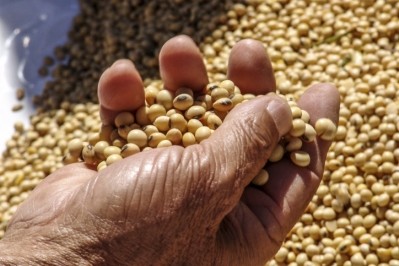Soybean group says US-China tariff woes not going away anytime soon

The American Soybean Association (ASA) has highlighted the ongoing trade uncertainty between the US and China could bring increasingly negative consequences and potentially irreversible ones for feed crop producers and rural America.
The ASA was opposed to the tariffs before they were put in place, said Ron Moore, director of ASA. The concern has now become that they will be in place for an extended period of time.
“Everybody has been surprised that we’ve got this tit-for-tat trade war going on where we put tariffs on and they put tariffs on,” he told FeedNavigator. “Everybody is nervous that this is going to be a long-term, multiyear issue with the tariffs.”
On Monday [September 24] the US imposed a 10% tariff on about $200bn in imports from China according to the office of the US Trade Representative. Those tariffs are set to increase to 25% in January.
In response, China implemented a series of supplemented tariffs on $60bn in goods. Tariffs on the product range from 5 to 10% and include fish fats, meals, pellets and oils, beef products, pork products, animal fats and oils, other animal proteins, soybean, corn and vegetable oil, soy-oil cake along with wheat and oat products.
The US administration also said that in the event of retaliation, it is prepared to add tariffs on an additional $267bn in products. However, that step has yet to be taken.
"I think if you take the president at his word then it’s likely that those [additional tariffs] will be coming forth at some point in the future if China doesn’t come to the negotiating table,” he added.
“It’s disappointing that we’ve got to this point, but I don’t think that President Trump or this administration is going to recommend that we get rid of the tariffs any time soon,” he said. “This will continue to escalate until somebody blinks.”
However, he added, suggestions that Chinese producers may reformulate feeds to cut the use of soybean meal could bring challenges for producers using those feeds.
Feed formulation
There have been some comments made that producers were trying to cut soybean meal use to limit the amount of imports needed, said Moore.
“Whether it’s poultry, or swine or dairy to reduce the amount of soybean meal that goes into the feed ration – that’s possible to do,” he said. “But over the long history of relationships with export markets like China and other Southeast Asian countries and European countries – it’s a premier protein source for animal feed and while there are other feedstuffs available it’s not as high quality as soybean meal.”
Reformulating rations could lead to reducing production efficiency and quality, he said. “It’s a short-term reaction but would have long-term effects on their livestock production – long-term negative effects,” he added.
“It sounds good, but if they spend much time looking at the research they’re going to realize that soybean meal it’s the premier protein for animal feed,” said Moore. “Their rate of gains will suffer, their cost and profitability will suffer and the quality of the pork and the poultry they produce will suffer.”
Lingering damage
The concerns regarding the time needed to recover from the ongoing tariff situation and trade uncertainty stem from history, said Moore. Previously a government intervention with the commodity market with Russia combined with high interest rates and large yields created a long-term challenge to feed crop producers.
“We had government intervention that caused a lack of confidence in the markets and people ended up not having a confidence in the marketplace and consequently – we had a lot lower prices and it took a decade for us to work through that,” he said. “There are a lot of similarities to what happened in the 1980s … to what we have right now.”
The price of US soybean has dropped by 20% at export terminals in New Orleans, the ASA reported. Farm gate prices have declined more steeply.
The financial support or market facilitation program announced by the USDA is expected to help soybean producers, said Moore. “We’d rather get our revenue from the marketplace instead of government assistance,” he added.
“We’re doing everything we can to engage with the administration to hopefully get some of these [addressed] in the short term, but we’re preparing for a long-term negative impact on the rural economy in the US,” he said.












